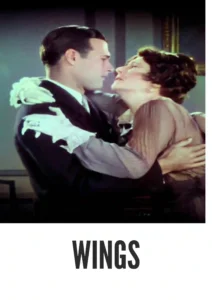Video Sources 0 Views

Synopsis
Soar into History with Wings: Now in Stunning Colorized HD

Experience the thrill of early aviation with Wings, the groundbreaking 1927 silent film that won the first-ever Academy Award for Best Picture. Directed by William Wellman and starring Clara Bow, Charles Rogers, and Richard Arlen, Wings delivers a breathtaking tale of love, rivalry, and sacrifice set against the backdrop of World War I. This colorized version brings a new vibrancy to the aerial combat and heartfelt drama, making it a captivating addition to any classic film collection.
Storyline: Love and War in the Skies
Wings tells the story of Jack Powell and David Armstrong, two young men from the same town who become rivals for the affections of Sylvia Lewis. When war breaks out, both enlist as fighter pilots in the U.S. Army Air Service. Amidst the dangers of aerial combat, their rivalry transforms into a deep bond of friendship. The film follows their journey through training, battles, and personal tragedies, showcasing the heroism and sacrifices of early aviators.
The Cast of Wings
Wings features a stellar cast that brings the thrilling story to life:
- Clara Bow as Sylvia Lewis
- Charles Rogers as Jack Powell
- Richard Arlen as David Armstrong
- Jobyna Ralston as Mary Preston
- Gary Cooper as Cadet White (uncredited)
Historical Significance: A Landmark in Aviation Cinema
Wings is a landmark film for its groundbreaking aerial photography and realistic depiction of World War I aviation . It was one of the most expensive films of the silent era and set a new standard for action and spectacle . Winning the first Academy Award for Best Picture cemented its place in film history. Wings offers a unique glimpse into the daring world of early flight and the human cost of war.
Colorization Details: Enhancing the Aerial Spectacle
This colorized version of Wings has been meticulously crafted to enhance the visual impact of the aerial sequences and bring depth to the period details. The addition of color adds a new dimension to the breathtaking aerial combat scenes and the poignant human drama, offering a richer and more immersive viewing experience.
Technical Specifications
- Original Title: Wings
- Genre: War, Romance, Action, Silent Film
- Director: William Wellman
- Runtime: Approximately 144 minutes
- Aspect Ratio: 1.78:1
- Color: Colorized (Originally Black and White)
Download Details
- Download Format: MP4
- Resolution: HD (1080p)
- Compatibility: Compatible with most devices including smartphones, tablets, computers, and smart TVs.
Experience the Thrill of Flight!
Download your HD colorized copy of Wings (1927) today and soar into the skies with this epic aviation classic! A must-have for every classic film enthusiast and aviation buff.




















